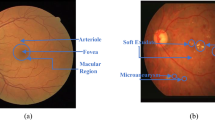Abstract
The paradigm of Fuzzy Morphology extends the concept of binary morphology to handle grayscale images. Fuzzy Morphology provides meaningful, local and simple operations that, when properly combined, form powerful transformations. We use this approach to segment out vessels in eye-fundus images, which can be used to diagnose medical conditions such as diabetic retinopathy. To automatically estimate the presence of such conditions, distinguishing vessels from other artifacts becomes a necessary initial step. To address the problem of segmenting curvilinear-like objects such as vessels, our methodology consists on applying the same structuring element rotated several times. We construct a vessel segmentation method and compare it with current state-of-the-art alternatives, showing the potential of our approach.
Access this chapter
Tax calculation will be finalised at checkout
Purchases are for personal use only
Similar content being viewed by others
Notes
- 1.
We use the concept of reflection with respect to the center of an image B as its rotation \(180^{\circ }\) around the central point. According to our notation, and assuming that B has size \(n_1 \times n_2\), it is formally defined as \(\overline{B}(x_1, x_2) = B(n_1 + 1 - x_1, n_2 + 1 - x_2)\). Although the definition is general, we will only consider structuring elements with \(n_1, n_2\) odd.
- 2.
Leave-one-out consists on training a method with all samples but one, and evaluate the trained classifier to the last one. This procedure is repeated with each sample to obtain all segmentations. Leave-one-out is useful when we have very few samples because the estimation given is realistic: to evaluate one sample, its ground truth is never used.
References
Beliakov, G., Pradera, A., Calvo, T.: Aggregation Functions: A Guide for Practitioners, vol. 361. Springer, Heidelberg (2007)
Bibiloni, P., González-Hidalgo, M., Massanet, S.: Vessel segmentation of retinal images with fuzzy morphology. VipIMAGE 2015 (2015, forthcoming)
Chanwimaluang, T., Fan, G.: An efficient blood vessel detection algorithm for retinal images using local entropy thresholding. In: Proceedings of the 2003 International Symposium on Circuits and Systems 2003, ISCAS 2003, vol. 5, pp. 21–24. IEEE (2003)
Fraz, M.M., Remagnino, P., Hoppe, A., Uyyanonvara, B., Rudnicka, A.R., Owen, C.G., Barman, S.A.: Blood vessel segmentation methodologies in retinal images–a survey. Comput. Meth. Programs Biomed. 108(1), 407–433 (2012)
Gonzalez, R.C., Woods, R.E., Eddins, S.L.: Digital Image Processing Using MATLAB, 2nd edn. Gatesmark Publishing, Knoxville (2004)
González-Hidalgo, M., Massanet, S., Mir, A., Ruiz-Aguilera, D.: On the choice of the pair conjunction-implication into the fuzzy morphological edge detector. IEEE Trans. Fuzzy Syst. 23(4), 872–884 (2015)
Hoover, A., Kouznetsova, V., Goldbaum, M.: Locating blood vessels in retinal images by piecewise threshold probing of a matched filter response. IEEE Trans. Med. Imaging 19(3), 203–210 (2000)
Kerre, E.E., Nachtegael, M.: Fuzzy Techniques in Image Processing, vol. 52. Springer Science and Business Media, Heidelberg (2000)
Mendonça, A.M., Campilho, A.: Segmentation of retinal blood vessels by combining the detection of centerlines and morphological reconstruction. IEEE Trans. Med. Imaging 25(9), 1200–1213 (2006)
Niemeijer, M., Staal, J., van Ginneken, B., Loog, M., Abramoff, M.D.: Comparative study of retinal vessel segmentation methods on a new publicly available database. In: Fitzpatrick, J.M., Sonka, M. (eds.) Medical Imaging 2004, vol. 5370, pp. 648–656. International Society for Optics and Photonics, Bellingham (2004)
Soares, J.V., Leandro, J.J., Cesar, R.M., Jelinek, H.F., Cree, M.J.: Retinal vessel segmentation using the 2-D Gabor wavelet and supervised classification. IEEE Trans. Med. Imaging 25(9), 1214–1222 (2006)
Staal, J., Abràmoff, M.D., Niemeijer, M., Viergever, M.A., van Ginneken, B.: Ridge-based vessel segmentation in color images of the retina. IEEE Trans. Med. Imaging 23(4), 501–509 (2004)
Zana, F., Klein, J.C.: Segmentation of vessel-like patterns using mathematical morphology and curvature evaluation. IEEE Trans. Image Process. 10(7), 1010–1019 (2001)
Zuiderveld, K.: Contrast limited adaptive histogram equalization. In: Paul, S.H. (ed.) Graphics Gems IV, pp. 474–485. Academic Press Professional Inc., San Diego (1994)
Aknowledgments
This work was partially supported by the projects TIN2013-42795-P and TIN2014-56381-REDT (LODISCO network). P. Bibiloni also benefited from the fellowship FPI/1645/2014 of the Conselleria d’Educació, Cultura i Universitats of the Govern de les Illes Balears under an operational program co-financed by the European Social Fund.
Author information
Authors and Affiliations
Corresponding author
Editor information
Editors and Affiliations
Rights and permissions
Copyright information
© 2015 Springer International Publishing Switzerland
About this paper
Cite this paper
Bibiloni, P., González-Hidalgo, M., Massanet, S. (2015). Retinal Vessel Detection Based on Fuzzy Morphological Line Enhancement. In: Puerta, J., et al. Advances in Artificial Intelligence. CAEPIA 2015. Lecture Notes in Computer Science(), vol 9422. Springer, Cham. https://doi.org/10.1007/978-3-319-24598-0_6
Download citation
DOI: https://doi.org/10.1007/978-3-319-24598-0_6
Published:
Publisher Name: Springer, Cham
Print ISBN: 978-3-319-24597-3
Online ISBN: 978-3-319-24598-0
eBook Packages: Computer ScienceComputer Science (R0)




